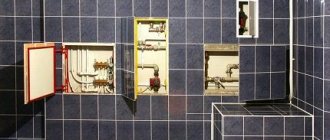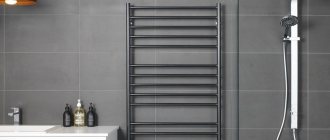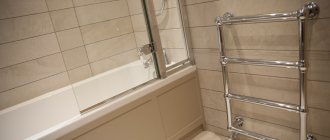What is the difference between an axial fan and a radial fan?
Let's look at the difference between an axial fan and a radial one. The design of this type of installation is simple and familiar to everyone. Any household fan or computer cooler is a clear example of such designs. The name “axial” means that the air flow created by the device moves along the axis of rotation of the impeller (impeller).
The design is extremely simple - an impeller with blades is installed on a rotating shaft. They have a specific shape, the rear part is slightly turned forward, due to which, when rotating, portions of air are captured by the leading edges of the blades, and the rear ones direct them forward.
Expert opinion
Online ventilation store “Runicom”
Axial designs have high performance, but most of them have very low flow pressure. They are used as household units, in industry they are used for rapid blowing of hot parts, prompt removal of harmful gases from process chambers.
The radial fan has a slightly more complex design . It consists of a carousel-type impeller equipped with blades and a housing that looks like a snail or spiral. Both elements work closely together and are useless separately.
The rotation of the impeller causes the blades to capture portions of air and throw them forcefully to the sides. The dispersion of air flows is prevented by the housing, which compacts and combines them into one common flow, discharged from the outlet. The resulting vacuum is replenished from the outside through an inlet located perpendicular to the axis of rotation. Thus, the flow entry occurs along the axis of rotation, and the exit occurs in the perpendicular direction.
Radial fans are capable of creating fairly high pressure . Some installations can compete with compressors in this indicator. This feature makes radial fans widely in demand in ventilation systems or technological installations that require overcoming the resistance of air ducts or creating an air flow with certain parameters.
Axial and radial fans have differences that determine the areas of use and functions performed. Axial designs are used primarily to solve local, local problems , while radial installations are needed to supply flow over long distances .
Home » Fan catalog » Multi-zone fans
It would seem that after the advent of duct fans it is difficult to come up with something new. However, it turns out that in this area there are original and promising solutions that save time, effort and money. These include multi-zone centrifugal exhaust fans , which have a special housing that allows you to connect several suction ducts that extract air from different zones. A zone can be a separate ventilation duct, a room, or part of a larger room. Such fans can be indispensable in facilities where exhaust must be made from several places, but there is only one ventilation duct for air exhaust . Multi-zone exhaust fans allow you to optimize the air duct network, reduce the number of expensive shaped products, while using the same type of flexible air ducts.
Multi-zone centrifugal exhaust fans save time, effort and money!
• By optimizing the air duct network, capital costs, labor intensity of installation and efforts to complete facilities with air ducts are significantly reduced. With a small range of components, there are great opportunities for designing exhaust systems. • Multi-zone centrifugal exhaust fans, as a rule, are multi-speed, which allows the use of inexpensive speed switches instead of expensive regulators • Shaped parts (tees, bends, transitions) require a lot of space and increase the network of air ducts, which causes additional costs for its decorative lining, which “eats » space, forcing you to arrange boxes and cornices. The use of multi-zone centrifugal exhaust fans in many cases eliminates these troubles. • Multi-zone centrifugal exhaust fans are designed for long-term continuous operation and have reduced noise characteristics. • Installation of one multi-zone centrifugal exhaust fan simplifies the operation of ventilation on site, because one fan needs to be serviced instead of several
Multi-zone fan Vort Platt
The Vort Platt multi-zone fan is designed to simultaneously remove air from 4 zones. The Vort Platt multi-zone fan can be mounted on the wall or ceiling. The ball bearing motor has multiple speeds. The multi-zone fan housing is made of ABS plastic with four suction pipes: 3 80 mm pipes and 1 125 mm suction pipe. Thanks to its flat shape and low height of 160 mm, the Vort Platt fan can be successfully installed above a suspended ceiling or behind a decorative box . This fan can be used for exhaust from almost any room, even those where the air has high humidity. At the moment, the production of the Vort Platt ES model has begun with an energy-saving motor and a timer that limits fan operation at maximum speed to a period of 30 minutes.
Multi-zone fan Vort Leto Mev
Multi-zone fan Vort Leto Mev is designed for simultaneous removal of air from several zones. The Vort Leto Mev multi-zone fan is mounted on the wall or ceiling . The ball bearing motor has three speeds. The multi-zone fan housing is made of ABS plastic with 4 125 mm suction pipes. The Vort Leto Mev fan is suitable for ventilation of almost any room, including those with high humidity and temperature. At the moment, the production of the Vort Leto Mev RF with a remote control that allows you to turn the fan on/off, change operating speeds, and activate the timer.
Multi-zone fan VMC Ariant
The Vmc Ariant multi-zone fan is designed to simultaneously remove air from 3-5 zones. The Vmc Ariant multi-zone fan is mounted on the wall and ceiling, or suspended on a nylon cord (this installation of the fan provides the best vibration insulation). The fan is equipped with a two-speed motor with ball bearings. The fan housing is made of self-extinguishing plastic V0. The fan has 4 80 mm suction pipes (2 of which have automatic air flow regulators of 15 and 30 m³/h, respectively, and two with plugs), and 1 125 mm suction pipe (equipped with a universal air flow regulator). Kit Vmc Ariant includes two exhaust anemostats 80 and one 125 mm, a two-position switch, and a nylon cord. The Vmc Ariant multi-zone fan is suitable for ventilation of almost any room, even those where the air has high humidity.
Multi-zone fan Vort Penta
The Vort Penta multi-zone fan is designed to simultaneously remove air from 2-6 zones. The Vort Penta fan can be mounted on a wall, ceiling, or suspended on a nylon cord (this installation provides the best vibration insulation). The fan has a two-speed motor. The fan has 5 suction pipes ∅ 80 mm (2 of which with automatic air flow regulators of 15 and 30 m³/h, respectively, and three with plugs), and 1 suction pipe 125 mm (equipped with a universal air flow regulator). The fan is supplied with a nylon cord. The Vort Penta multi-zone fan is suitable for ventilation of almost any room . At the moment, the Italians have also started producing the Vort Penta ES model with an energy-saving engine.
Multi-zone fans Elf B
Elf multi-zone fans are designed to simultaneously remove air from 1-4 zones. Elf fans are mounted on the wall and ceiling. The fans have four-speed motors. Elf B exhaust fans are available in two sizes: Elf 6V and Elf 9V. They have the same dimensions and differ in fans, as well as the diameter of the discharge connection pipes. On the suction side, Elf B fans can have one pipe with a diameter corresponding to the discharge pipe, or several suction pipes with a diameter of 160, 200 or 250 mm. Multi-zone fans Elf B are suitable for ventilation of almost any room.
Channel from axial
Let's look at the difference between a duct fan and an axial fan. It should be noted that the comparison is not entirely correct, since the term “channel” refers to the area of use, and “axial” refers to the design .
Duct fans are devices placed in the gap of air ducts and designed to increase the energy of the air flow. In addition, they are used to increase the efficiency of natural exhaust in residential buildings and serve to increase the impulse of air flows after branching.
Externally, they most often represent a section of air duct with a fan located inside. Different types of devices are used, from axial to radial . There are also direct-flow radial fans, which are something between an axial and radial design - the air flow is created by a drum with blades, but they are strongly inclined and direct the flow not tangentially, but along the axis of rotation.
Expert opinion
Online ventilation store “Runicom”
There is no point in talking about the difference between channel and axial types, since in this case a comparison of completely different categories is made.
Climate
29 votes
+
Vote for!
—
Vote against!
Increased humidity in the bathroom has not been a secret for a long time. To ensure clean and fresh air in the room, you need to ensure good ventilation. People try to combat high humidity in a variety of ways. However, the time has passed when you need to open the doors to the room after taking a shower and remove the water from the floor. It's time to move on to drastic measures - buying a fan for the bathroom.
- Performance
The importance of bathroom ventilation
Ventilation in the bathroom is important for human health. Typical bathrooms have a small area. Therefore, when taking a bath or shower, the room quickly fills with steam. Dampness settles on the ceiling and walls of the room, causing the bathroom finish to deteriorate. Now think about whether you need a fan in the bathroom?
Splashes of water, condensation and fumes can lead to the unwanted formation of mold and mildew, which results in unpleasant odors, harmful small insects and their noxious secretions. Removing odors and moist air is essential for your comfort and reducing the risks of allergies and respiratory diseases.
As a rule, there is no window in the bathroom. And the only way to get fresh air into the bathroom are ventilation systems. When building a house, builders must plan natural ventilation channels. The effectiveness of the ventilation system depends on the direction and location of the air flow.
Often, natural ventilation systems do not cope with their task. To check whether the natural ventilation system in the bathroom is working effectively, it is enough to carry out a small, simple test. Take a piece of paper and place it on the grill. It will stick to the grille if the system is working properly - it will be held by the air flow.
If the ventilation does not work well, the leaf will not be held. However, it should be remembered that even a normally operating system demonstrates low performance, since the principle of its operation is based on the difference in temperature in the bathroom and outside. In the summer, when it is hot outside, the ventilation hardly works.
Also, ventilation ducts become clogged over time, and the entire system loses efficiency. Remember, if in your home condensation accumulates on the surface of the walls, plumbing fixtures and furniture in the bathroom, the mirrors in the bathroom fog up and there is a constant unpleasant smell in the toilet, you should install an exhaust fan in the bathroom.
Types of exhaust fans
When purchasing a fan for a bathroom, it is worth reading that such devices are structurally divided into duct and axial, radiator and roof, which is determined by the features of their application.
Axial fans
Axial bathroom exhaust fans are a wheel with cantilever blades located in a cylindrical housing. The impeller is usually mounted on the axis of the electric motor. When the wheel rotates, air is captured by the blades and moves in the axial direction. There is practically no movement of the air mass in the radial direction.
A manifold is installed at the entrance to the bathroom hood to improve the aerodynamic characteristics of the fan. Axial models show a fairly high operating efficiency compared to other devices - productivity is more than 100 cubic meters per hour, but their pressure characteristics are low. They can be installed directly into the wall.
This type of bathroom exhaust fans is quite common due to its ease of installation. Mount wall fans into the ventilation shaft openings. In principle, such installation is a violation, because air circulation may be disrupted in general ventilation. The disadvantages of wall-mounted axial fans include a higher noise level, which often reaches 30–50 dB.
Radial fans
Fans of this type consist of a blade wheel located in a spiral casing. When the wheel rotates, air enters the holes between the blades, follows to the periphery of the blade wheel in the radial direction, is compressed and thrown under the influence of centrifugal force into a special spiral casing and then enters the discharge hole.
The working hollow cylinder has blades along the side surface, which are located parallel to the axis of rotation at an equal distance. In air cooling and ventilation systems, the quietest radial bathroom fans are used, with single or double suction, with blades curved forward or backward.
The use of radial fans, the blades of which are directed backwards, allows saving 20% of energy. Another important advantage is that they can easily withstand air flow overloads.
Bathroom exhaust fans with forward-curved blades can provide similar pressure and flow characteristics as units with rear-facing blades, with a smaller impeller diameter and low rotating speed, helping to achieve good results while creating less noise and taking up less space.
Centrifugal fans
Centrifugal duct-type fans appeared quite recently (70s), but gained great popularity due to their convenient use and considerable simplicity. Duct fans for the bathroom are used when the room area is more than 15 square meters.
The devices themselves are quite powerful, but the noise level is rated as low. Silent duct-type bathroom exhaust fans are designed to be placed in the flow part of the ventilation system. They come with a rectangular or round cross-section. Typically, a duct fan is installed under the ceiling and hidden behind plasterboard panels.
It is advisable to choose semi-rigid or rigid air ducts, because their design is considered more reliable than flexible ones - this ensures a longer service life. The centrifugal fan can be mounted in the middle of the duct or in front of the air intake opening.
Although the latter option is not very convenient, since it requires the installation of an anemostat, which prevents condensate from entering the ventilation system. However, in the first situation there are also disadvantages - due to the aerodynamic resistance of the air ducts, you need to install a more powerful fan.
Roof fans
Roof hoods are installed on the roofs of residential buildings. Roof-mounted fan units consist of a fan, an electric motor, vibration-isolating pads, as well as automatic control devices, all contained in one housing. These devices use axial multi-blade or radial devices with single or double suction blades.
Choosing a bathroom hood
When choosing a fan for the bathroom, you need to remember some parameters and technical characteristics, such as air exchange and performance, noise level and safety in a moisture-saturated environment, as well as the functionality of the devices and the price-quality ratio.
Performance
To calculate the required fan performance for your bathroom, you will need the following information: the volume of the room and the air exchange rate - the number of air changes per hour. The product of these two indicators will be the fan performance.
You can calculate the fan power using the following calculations. Calculate the volume of the room by multiplying the length of the room by its width and height, and rounding up. To obtain productivity, multiply the volume of the room by a number that shows how many times the air should be changed to fresh air in one hour.
The air exchange rate always depends on the type of room and is specified in building codes. This number for a bathroom according to building codes is 6-8. Take 6 if 1 - 3 people use the bathroom in your house, if more than 3 - substitute or 8. The air exchange rate for the toilet will be 6-10.
After the calculations have been made and the performance obtained, you can choose the best fan for the bathroom according to the parameters of various manufacturers that produce exhaust fans. Practice shows that it is necessary to take a fan that has technical indicators slightly higher than the calculated parameters. Typically, the performance of bathroom fans is 95 - 100 m3 / hour.
Noise level
Each bathroom fan is driven by an electric motor, the operation of which is always accompanied by two types of noise - mechanical and aerodynamic. The first noise can penetrate into the premises, spreading through the air duct, and the second one arises as a result of vibration of structural elements - the walls of the exhaust fan protective casing and the air ducts themselves.
Noise that is more than 35 dB has an irritating effect on the human psyche. Therefore, noise control is an urgent task when choosing and installing exhaust fans for the bathroom. Thus, the noise produced by the device should not exceed 30 dB. If you are thinking about how to buy a bathroom fan to turn on the device at night, then remember that the noise level in this case should not exceed 25 dB. Noise indicators are indicated in the passport data.
The noise level can also be reduced by installing a silencer behind the fan and lining the inner surface of the air duct with sound-absorbing material. Silencers have two main designs - tubular and plate. In any case, the diameter of the air ducts should not be too small so that air “plugs” do not form due to turbulence of air flows, but it should not be excessively large, which increases the material costs of a large bathroom fan.
Security issue
Another important requirement for a bathroom hood is its protection from moisture entering the appliance. An exhaust fan is an electrical appliance, and the bathroom is always humid. Contact with unprotected parts of the device or switch (and any electrical device has them) can cause a short circuit and significant consequences for the electrical wiring - such as a fire. This should be taken into account every time the question arises of how to choose a bathroom fan.
To avoid this, look in stores for fans that are designed specifically for the bathroom. They are marked accordingly. These are ordinary hoods, which are additionally protected against water penetration. For complete safety, bathroom exhaust fans use predominantly a voltage of 24 V. If a short circuit occurs in the wiring, such a low voltage will save the bather’s life.
Hood functionality
If you still haven’t decided which fan is best for the bathroom, you should also focus on such an important point as functionality. There are two types of bathroom hoods: automatic and standard. Standard exhaust fans are ordinary axial systems with a check valve that blocks the flow of exhaust air back into the room.
Such fans work very simply: when the light is turned on, the air exhaust starts working at the same time, when turned off, the fan stops. This is convenient, but not always practical, especially when the moisture level is very high, because such a fan will not be able to remove all the humid air from the bathroom in a short period of time.
Automatic bathroom exhaust fans are naturally more advanced, but also more expensive. They are equipped with special timers to set the device for a certain operating time. Exhaust fans with a sleep timer run for approximately 25 minutes after you leave and then turn off automatically. A fan with a humidity sensor and timer will turn on when the humidity increases above a specified limit and turn off after a time period specified by you.
How to choose a fan for the bathroom if the bathroom ventilation system is connected to the kitchen ventilation system? Bathroom hoods with a check valve are also available on the market. These devices will be a real boon if the bathroom and kitchen ventilation systems are a single whole. This type of fan draws air out of the room, preventing it from entering the kitchen.
Price-quality fan
Next, pay attention to the quality of the bathroom fan, because high technical characteristics do not always guarantee long-term operation of the device. It is better to look at the offers of famous manufacturers of bathroom fans. Positive characteristics and consumer reviews will signal that your choice has fallen on a worthy device.
Confirmation of quality is the exhaust fan’s compliance with quality standards and the presence of certificates from special commissions, warranty documents and markings, which indicate the protection class (start from the lowest value - IP 34). Remember that a bulky hood will not always be of high quality.
Today, the size of bathroom fans is in most cases compact, but the devices are quite powerful. Also on the market are built-in appliances that forcefully remove moist air from the bathroom into ventilation shafts.
A good quality bathroom fan doesn't always have to be expensive. Even the most inexpensive and simple domestic device will efficiently cope with its tasks for 3-5 years. And you can always buy a more expensive device, especially if you are interested in the high functionality of the fan.
The bathroom is one of the most humidified places in an apartment or private house. Without a doubt, the answer to the question “How to choose a fan for the bathroom?” you already know. Let us make a reservation once again that compact, but at the same time powerful models of splash-proof hoods are designed for wet rooms, the design of which prevents water from entering the air duct, minimizing the risk of a short circuit. Basically, we have listed all the criteria for choosing bathroom exhaust fans. Now all that remains is to consider installing a hood in the bathroom yourself.
Radial from centrifugal
The most interesting question that arises among unprepared people is: centrifugal and radial fans - what is the difference? The answer is simple - there is no difference. These are different names for the same device ,
Confusion in terminology has arisen due to the lack of clear regulation of notation . Specialists do not have any significant problems because of this, but for unprepared people there are often discrepancies in this issue. Therefore, you should simply remember that radial and centrifugal installations are the same type of equipment , not similar or similar in design, but precisely the same devices.
WHY DO YOU NEED AN EXHAUST FAN?
Removing water vapor and, accordingly, reducing air humidity is the main reason why it is necessary to install an exhaust fan in bathrooms.
High air humidity can cause: wet spots on walls, floors and ceilings, corrosion (rusting) of metals, the appearance and development of mold and mildew, peeling and destruction of decorative coatings (paint, wallpaper, tiles), the appearance of condensation, fogging of glass and many other unpleasant events. Also, the use of exhaust fans in a bathroom or toilet has a number of other positive aspects, such as removing unpleasant odors, improving air circulation, etc.
Natural ventilation, through door cracks or a ventilation duct, cannot always cope with this task effectively, so I advise everyone to install forced ventilation in bathrooms - exhaust fans.











